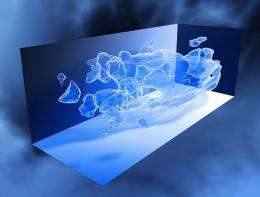December 10, 2010 feature
Physicists propose mechanism that explains the origins of both dark matter and 'normal' matter

(PhysOrg.com) -- Through precise cosmological measurements, scientists know that about 4.6% of the energy of the Universe is made of baryonic matter (normal atoms), about 23% is made of dark matter, and the remaining 72% or so is dark energy. Scientists also know that almost all the baryonic matter in the observable Universe is matter (with a positive baryon charge) rather than antimatter (with a negative baryon charge). But exactly why this matter and energy came to be this way is still an open question. In a recent study, physicists have proposed a new mechanism that can generate both the baryon asymmetry and the dark matter density of the Universe simultaneously.
The scientists, Hooman Davoudiasl from Brookhaven National Laboratory in Upton, New York; David Morrissey and Sean Tulin from TRIUMF in Vancouver, British Columbia; and Kris Sigurdson from the University of British Columbia, also in Vancouver, have published their new proposal in a recent issue of Physical Review Letters. They’ve dubbed the new mechanism "hylogenesis" from the Greek words "hyle," meaning "primordial matter," and "genesis," meaning "origin."
"There are two problems in theoretical physics we are trying to address at once," Sigurdson said. "The baryon asymmetry (why do we have atoms but not antiatoms in the Universe?) has really been a problem since Paul Dirac proposed antimatter in 1928 and it was discovered in 1932. And what is the dark matter? Hints of dark matter have been around since Fritz Zwicky discovered missing mass in the Coma Cluster in 1933, but its identity is still unknown. This mechanism links the formation of atoms and dark matter and helps resolve the baryon asymmetry mystery, as the total dark plus visible baryon balance of the Universe is restored."
In this matter-formation scenario, a new particle X and its antiparticle X-bar (of equal and opposite charge) are produced in the early Universe. X and X-bar are capable of coupling to quarks (the basic components of baryonic matter, e.g., protons and neutrons) in the visible sector as well as particles in a “hidden” sector (so-called because the particles in it interact only feebly with the visible sector). In this scenario X and X-bar would have been produced when the Universe heated up after inflation, in the first moments after at the start of the big bang.
Later, X and X-bar would decay, partly into visible baryons (specifically, a neutron made up of one up quark and two down quarks) and partly into hidden baryons. As the scientists explain, X decays to neutrons more often than X-bar decays to antineutrons. By the same amount, X-bar decays to hidden antiparticles more than X decays to hidden particles. In this scenario, the quarks would be the baryonic matter that makes up almost everything we see, and the hidden antibaryons would be what we know as dark matter. Through this yin-yang decay pattern, the positive baryon number of the visible matter is in balance with the negative baryon number of the dark matter.
“The energy densities of visible and dark matter are really close to each other (differing by a factor of five),” Tulin said. “In many scenarios, the processes that generate visible and dark matter are unrelated, occurring during widely separated epochs in the early universe through completely different physics. So, this factor of five seems like either a really big coincidence, or it could be a clue that both kinds of matter had a common origin. I think this is the main reason to take seriously these unified models of visible and dark matter genesis.”
The physicists predict that this matter-formation mechanism could provide an entirely new way to look for dark matter, since it would leave a signature that could be experimentally detected. As they explain, once in a while a dark matter antiparticle might collide with and annihilate an ordinary atomic particle, releasing a burst of energy. Although this is very rare, there is a chance that experiments on Earth that look for the spontaneous decay of protons could detect dark matter.
“We plan to investigate, in more detail, the prospects for dark matter detection in nucleon decay experiments, as this constitutes a distinct signature of our proposal and can open up a new front in the experimental search for dark matter,” Davoudiasl said. “Other potential signals of hylogenesis can appear in astrophysical observations and perhaps particle accelerator data, and we intend to consider these possibilities in our future work as well.”
More information: Hooman Davoudiasl, et al. “Unified Origin for Baryonic Visible Matter and Antibaryonic Dark Matter.” Physical Review Letters 105, 211304 (2010). DOI: 10.1103/PhysRevLett.105.211304
Copyright 2010 PhysOrg.com.
All rights reserved. This material may not be published, broadcast, rewritten or redistributed in whole or part without the express written permission of PhysOrg.com.
















